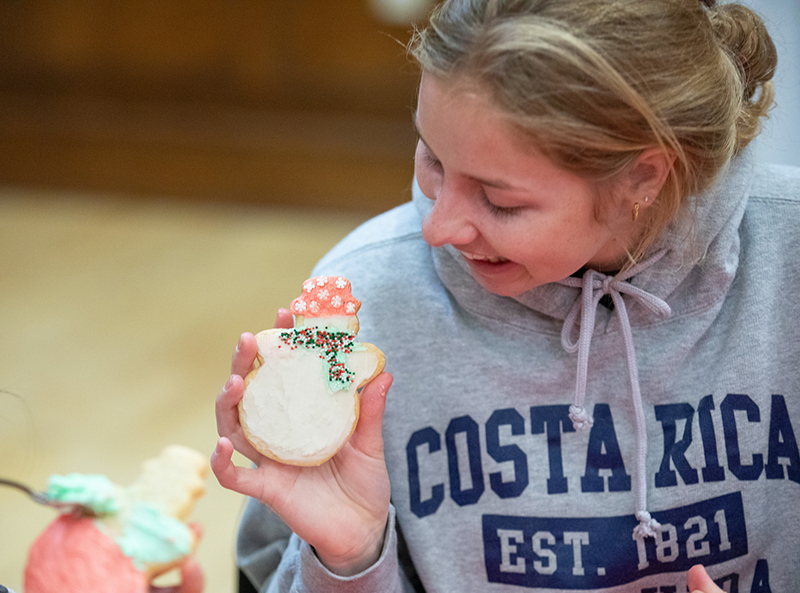Making room for a west side building

Photo by Christopher Gannon.
A crew is working this month to complete an extension to Lot 1 near Martin and Friley (pictured) residence halls in the southwest corner of campus. Expanding this lot is a necessary step in plans to construct a new building for the industrial and manufacturing systems engineering department northwest of Beyer Hall. Much of the Therkildsen Industrial Engineering Building's footprint will be on what currently is Lot 3. The Lot 1 expansion is scheduled for completion by the end of December.
In mid-December, a section of Sheldon Avenue will close for a few weeks to extend sewer lines to the Therkildsen building site. In early January, construction fencing will cordon off the site so construction can begin.
Faculty, staff face read-only status in Google next month
Unless it can reduce its data storage in Google Drive and Google Photos by more than 60%, the Iowa State community is about a month away from lapsing to read-only status for files stored there. This means employees could download or read files, but they wouldn't be able to create or edit files.
Like other cloud storage providers, last year Google halted its policy of unlimited storage for higher education clients and put them on alert that quotas were coming. Google set Iowa State's storage limit at 100 terabytes (TB), or 100,000 gigabytes (GB), with enforcement set to begin in January. Here's the rub: University employees currently store nearly 275 TB in Google products: about 256 TB in Google Drive and more than 18 TB in Google Photos, said Jason Shuck, who manages the systems operations team in information technology services (ITS), which oversees data storage. And, despite a yearlong messaging campaign to appeal to the largest storage users on campus, employees have been slow to move or delete files.
Individual quota
As a strategy to meet the institution's quota, starting Jan. 3, ITS will enforce a 3 GB quota for all individual Google Drive accounts. Any accounts exceeding that will move to read-only status until they meet the quota. Shuck said on Jan. 3 a message across the top of their Drive site will alert employees who are near or over their personal storage limit. Prior to Jan. 3, employees can see their current use under "storage" in the left column of Drive.
Google will enforce the 100 TB university quota, and Shuck said that will happen sometime after Jan. 1. When it does, individual account compliance would become irrelevant because Google looks only at total institutional storage.
Google storage is the least used of three options available to ISU employees. Iowa State has contracts for storage with Microsoft (OneDrive is included in the Office 365 package) and Box.com (branded CyBox). Faced with the decision to purchase additional storage from Google, senior leaders decided against paying for a third storage option.
The business model for cloud storage has changed, and it's taking time for all customers to adjust to the new structure and expectations, Shuck noted.
"We don't have a choice. Google initiated these changes and we have to adapt," he added. The days of free, unlimited data storage are gone.
Options in the university solution
To help the university meet its quota, Shuck suggests these strategies for data stored in Google:
- Delete files. This is an appropriate choice for personal use files, unused or obsolete files and duplicated material owned by someone else.
- Move files. Iowa State has new, multiyear contracts for generous storage in OneDrive and CyBox, Shuck said. There's not a concern about capacity with either option. A knowledge base article, Export Your Google Drive Content, shows employees how to move files. For ITS assistance migrating files to OneDrive, complete the form, Request Managed Migration to OneDrive. ITS staff also can create a shared space in CyBox for departments or units; email storage@iastate.edu to request assistance.
- Remember to delete files from Google that were successfully migrated to CyBox or OneDrive.
- Android phone owners should not sign into Google with their Iowa State account (use a personal account) on their phones. Many aren't aware their phones automatically back up their photos to Google Photos, which contributes to the university's overall data storage. Plus, they may risk deletion of their photos with the storage cap.
- Advisors to student organizations are reminded that those organizations should be storing files in CyBox or OneDrive. Google's policy for student club data puts that information at high risk for accidental deletion, Shuck said.
For more information or assistance, email storage@iastate.edu.
Cotos, Greenlee named associate deans in Graduate College
Two longstanding faculty members have been appointed to newly developed leadership positions in the Graduate College: Elena Cotos as associate dean for professional development and Heather West Greenlee as associate dean for student and scholar success.
Both will serve four-year, half-time appointments beginning Jan. 1.
"We are excited to add Elena's and Heather's expertise to the Graduate College's leadership team," said dean William Graves. "These new positions will support graduate students from application to graduation and beyond, while also working with colleagues across the university to grow graduate enrollment and programs.
Communications, career services, mentoring
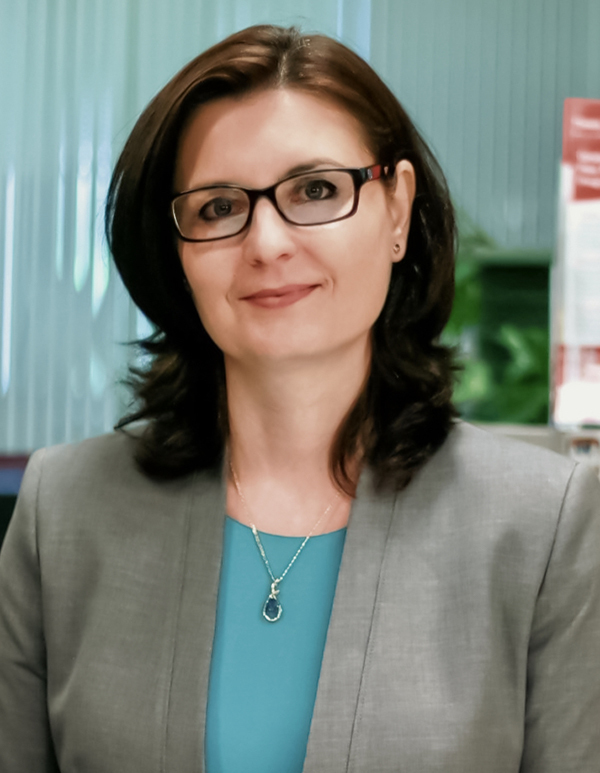
Elena Cotos
Cotos, associate professor of English and director of the Center for Communication Excellence in the Graduate College, joined Iowa State in 2009. She holds a bachelor's degree in English language/literature and translation/interpreting, and a master's degree in philology, both from Moldova State University, Kishinev; and a Ph.D. in applied linguistics and technology from Iowa State.
In her new role, Cotos will lead programs related to the professional development of graduate students and postdocs, including continued oversight of the Center for Communication Excellence, enhanced career services, faculty mentoring and the Graduate College Emerging Leaders Academy. She also will serve as Iowa State's co-lead with the Center for the Integration of Research, Teaching and Learning, a multi-institutional program supported by the Center for Excellence in Learning and Teaching.
Enrollment and program growth
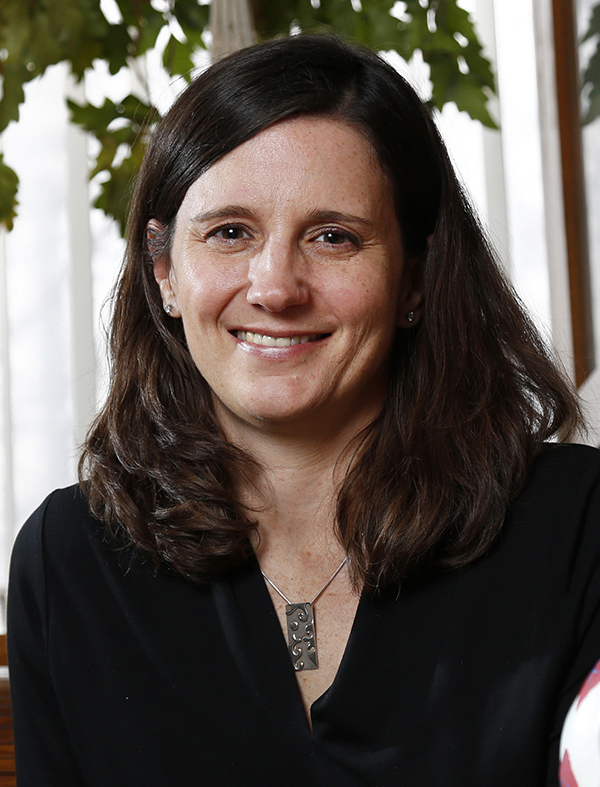
Heather Greenlee
Greenlee, the Lora and Russ Talbot Endowed Professor in Veterinary Medicine, joined Iowa State's department of biomedical sciences (BMS) in 1999. She holds a bachelor's degree in biology and Ph.D. in neuroscience and zoology, both from Iowa State. A former equity advisor for the College of Veterinary Medicine and current director of graduate education in BMS (through Dec. 31), Greenlee also is a visiting scientist at the USDA National Animal Disease Center.
As associate dean, Greenlee will lead the college's efforts to grow graduate student enrollment through improvements in recruitment and admissions, student onboarding and retention, and advising and mentoring by major professors. She also will work with the disciplinary colleges and their graduate faculty to develop new graduate programs that are responsive to student and employer demand, including an initial focus on coursework-only master's degrees.
In addition to Cotos and Greenlee, Michelle Soupir, professor of agricultural and biosystems engineering, also serves as interim associate dean for operations in the Graduate College.
Ally makes Canvas content more accessible
Ally, a digital accessibility tool for students and faculty, will be available for all Canvas courses beginning Jan. 3. It guides instructors on how to improve the accessibility of course content, making it available to more students in alternative formats.
Ally trainings
-
Jan. 10: 10 a.m.-11 a.m., Ally basics (in person Durham 116 in the Digital Accessibility Lab and virtual. Will be recorded)
-
Feb. 14: 10 a.m.-11 a.m., Ally dashboard and reporting in-depth (in person Durham 116 in the Digital Accessibility Lab and virtual. Will be recorded)
-
March 7: 10 a.m.-11 a.m., Ally refresher and FAQs (in person Durham 116 in the Digital Accessibility Lab and virtual. Will be recorded)
When instructors upload content to Canvas, it's automatically scanned to determine accessibility and alternative file formats are created:
- Tagged PDF: Structured PDF for improved use with assistive technology
- OCRed PDF: Makes scanned documents searchable and more readable while reducing file size
- ePUB: Content readable on a tablet device as an e-book on an iPad and other e-book readers
- Audio: MP3 version for listening on personal devices. Reads like a screen reader, not a book narrated by a person
- HTML: Strips out style code to focus on text for viewing in the browser and on mobile devices
- Immersive reader: Aids reading comprehension and grammar skills
- Beeline reader: Enhanced version for faster and more focused on-screen reading
- HTML: Strips out style code to focus on text for viewing in the browser and on mobile devices
- Electronic braille: Version for consumption on electronic braille displays. Hardware that features a line of braille cells, and pins in each cell move up and down to allow users to read a line of braille text. It can be connected to computers, smartphones and tablets.
- Translated version formats: A machine translated version of the original document
Instructors see what content is and is not accessible through the tool's dashboard, and it recommends fixes to inaccessible content.
"It will not fix it for you, but it will guide you," said digital accessibility lead Cyndi Wiley. "Instructors can do the easy fixes first because that will immediately boost accessibility, and they can get help for bigger issues. It really customizes a student's learning experience."
Some of the easier fixes include repairing broken links or ensuring PDFs are navigable with assistive technology like screen readers. The dashboard displays an accessibility score from zero to 100. ISU's goal of 85 for all course content by 2026 would match the industry standard.
"It is not meant to be punitive. It just gives instructors an idea of what it might take to have their content be most accessible to students," Wiley said. "It will be working in Canvas, but they choose how much they want to engage with it."
The addition of Ally is a significant step in complying with the university's digital accessibility policy. The policy takes effect July 1, 2026, to ensure individuals with disabilities can independently acquire the same information, engage in the same interactions and enjoy the same services within the same timeframe as individuals without disabilities.
Testing
Ally is being tested in 30 courses this fall, including large lecture, studio, science and lab courses to get a varied sample. Wiley monitors how many students take advantage of the different formats, which are most popular and how much time they spend with the content. The tool also supplies a report to instructors to see how students are interacting.
Wiley said most of the feedback in the test has been positive because of the ease of use for instructors, and it helps put them in an accessibility mindset when preparing new content.
"This is something we want instructors to focus on going forward and not worry about going back to previous content they have created," Wiley said.
Choosing Ally
Prior to the pilot test, Wiley put Ally through numerous tests acting as a graphic design faculty member teaching graduate courses in human computer interaction. Wiley added it to courses that included a syllabus, numerous modules, course content, assignments, videos and PDFs. One of Ally's biggest strengths is the ability to upload large files quickly and scan each piece of content for accessibility.
Iowa State's request for proposal process for this tool will help other regent universities by using ISU's procurement processes.
"It is really good when that can happen because it shows collaboration between regent universities," Wiley said. "It leads to better pricing and more support for the students."
The first year of Ally is funded by the Committee on the Advancement of Student Technology for Learning Enhancement, which advises President Wendy Wintersteen on how to use the student technology fee.
Other Canvas updates
-
Canvas no longer will sunset Classic Quizzes in June 2024. Instructors can choose to use Classic or New Quizzes with all quiz creation. The Center for Excellence in Learning and Teaching (CELT) will continue to offer New Quizzes training, and Canvas will determine a new deadline for the switch.
Data storage
OneDrive was installed in Canvas on Dec. 1 in conjunction with the university's move from Google data storage to Microsoft.
"Google is putting a data cap on the university Jan. 3, and if we exceed the cap, everything will become read-only," said Angi Beau-Karthik, CELT instructional technology specialist.
Instructors, especially those teaching during the winter session, are encouraged to begin moving content from Google to Microsoft. Any content shared in Canvas courses should be the highest priority to avoid issues during winter session.
Instructors using Canvas collaborations with Google will retain the option in Microsoft. Turnitin Draft Coach -- which helps students improve their academic writing and research skills -- will switch to Microsoft after the fall semester, Beau-Karthik said. Microsoft Teams classes and meetings also were added to Canvas.
- The Class Climate platform where students' rating of teaching surveys are found is under the "My Surveys" tab in any of the course navigation menus. Surveys for all courses are there. Instructors are encouraged to remind students to fill out the surveys, and can find the response rate by clicking on "My Surveys."
- A new integration of the app Top Hat, which increases in-class engagement and allows for real-time feedback, is being piloted during the fall semester and became available to all courses on Dec. 1. Roster syncing occurs automatically when the students click the Top Hat link in Canvas, and instructors have the option to automatically sync their gradebook with Canvas. The current integration of Top Hat will remain active until Jan. 3, ensuring fall semester courses are complete.
- The fall Gradescope pilot is nearly complete and a decision on its future will be made soon. It is an assessment, feedback and analytics tool that enables instructors to administer, grade and provide students feedback on pen-and-paper, bubblesheet and computer programming assignments.
Questions on any Canvas updates can be emailed to celt-help@iastate.edu.
Game2Work strives to demystify STEM, show games' value
Parents worry children spend too much time playing video games, but there are plenty of opportunities -- especially with serious games -- to build collaboration and social skills. Game2Work (G2W) is a research community on campus that uses games to strengthen work and learning for the digital generation.
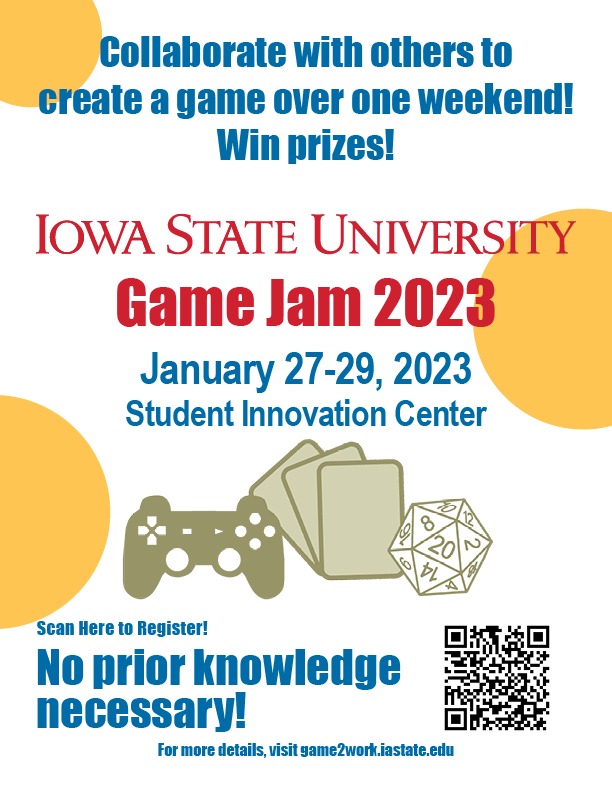
"Games have a stigma attached to them, where some people think it's a waste of time," said Michael Dorneich, professor of industrial and manufacturing systems engineering and co-lead on the project. "There is a lot of serious work with a lot of serious intentions with what you are trying to produce."
School of Education assistant professor Michael Brown, a G2W co-lead, said games are good at engaging people. Many games focus on cooperation or building STEM skills. Cooperative games -- It Takes Two or Overcooked, for example -- are not based on competition, because winning occurs by working with teammates. Other games act as gamified tutors, giving students the opportunity to learn with someone else. To succeed, they must work together to solve challenges.
Pathfinders
Up next
The next game jam, for undergraduate students, will be held Jan. 27-29 at the Student Innovation Center. Game proposals, prototypes or turning an existing game into a usable product will be accepted. No game design experience is needed. For more information about the game jam, visit the website or email Brown.
Within G2W, pathfinder projects assemble a group to focus on a topic. One of the most successful so far is a game jam, geared toward undergraduates or middle schoolers who spend two to three days on campus addressing a problem by building a game. Mentors work with the groups, keynote speakers share experiences, and judges determine success after students' presentations.
"Giving them authentic experiences in STEM demystifies it a little bit," Dorneich said. "They realize they can see themselves doing it while counteracting a lot of negative messages groups receive."
STEM
Brown works to help teachers supplement STEM education with serious games. The goal is to provide hands-on learning that offers a break in the way information is delivered. Serious games like Wingspan or Photosynthesis that focus on teaching science concepts are ideal for supplementing the existing curriculum. They reinforce important concepts for young learners by engaging them in play, he said.
Teachers take existing games and implement them while adding elements of gamification into their curriculum. Brown is helping ISU Extension and Outreach and 4-H clubs build toolkits so instructors have a ready-made lesson plan.
"If you ever watch a young person play a game, they die, come back and do the task again," he said. "If you ever watch them try to solve a math problem, they don’t necessarily have that mindset. They are often not thinking, 'What did I do wrong? How do I do it differently? How do I do it again?' Games can cultivate persistence."
Brown also developed a personalized dashboard in Canvas for undergraduates in a variety of STEM courses that use gamification techniques to encourage engagement. The dashboard breaks down successful actions students need to take in their class weekly, areas of strengths and opportunities for improvement on assignments, class ranking for those motivated by competition, and badges earned for success in concepts.
Brown, who has had three cohorts of students use the dashboard, sees improvement by about half a letter grade compared to students not using it. He hopes to work with community colleges across the state to implement the dashboard.
Getting started
G2W began in 2020 through a four-year Presidential Interdisciplinary Research Initiative grant. The grant supports the beginning stages of new interdisciplinary research that has strong potential to attract external funding.
"It brings researchers at Iowa State together to begin research that would otherwise not happen," Dorneich said. "The hope is it leads to newer, bigger grants, more outreach and creates a center of research here."
Dorneich said the high use of games in teaching and research at ISU makes it a natural place to begin and develop that work. Currently, the core group has 12 faculty members, ranging from the School of Education to the psychology and several engineering departments. Game projects enhance research and teaching. For example, electrical engineers use them to teach cybersecurity.
The group meets monthly year-round to build community.
First conference
October's inaugural Game2Work Day allowed the team to bring statewide entrepreneurs, educational technology experts, game developers and others to campus to share ideas. The day included an expert panel, breakout sessions and four-minute lighting talk presentations. Attendees learned about G2W, but also it served to educate faculty on needs and trends in their research.
Dorneich said one of the biggest takeaways from the six-hour gathering was how large of an appetite exists on both sides.
"Employers want to hire ISU graduates, but marrying all the skills needed is a work in progress," he said. "Students have a strong desire to work in the gaming community, but the path can be challenging."
There already is an effort to develop an undergraduate gaming major because the need stretches beyond designers to individuals who can help round out content and information -- story, music and visuals -- to games.
Caps raised for voluntary retirement plans
The IRS has increased some, but not all, limits on employee contributions to voluntary retirement plans for calendar year 2023. The standard annual limit will go up $2,000, to $22,500. The annual limit for an optional "catch-up" contribution for employees who are at least 50 years old on Dec. 31, 2022, goes up $1,000, to $7,500.
These changes are unrelated to the ISU mandatory retirement plan or contributions to IPERS. Voluntary retirement savings plans are for additional employee contributions, and the university doesn't provide a match to these plans. Iowa State offers two options for voluntary retirement savings: 403(b) and 457(b) plans.
For employees who have selected "maximum amount" for their contributions, the system will adjust to the new limit amounts; employees don't need to make any changes. For those who selected "maximum amount" and meet the age requirement, the maximum amount also will include the age 50+ catch-up limit, effective Jan. 1.
Changes to voluntary retirement accounts can be made any time in the Retirement@Work website, since last spring one of the apps available on the Okta sign-on page. A tutorial explains how to use the site.
403(b) and 457(b) voluntary retirement plans: Contribution caps
|
|
Calendar year 2023 |
Current |
|
Standard limit |
$22,500 |
$20,500 |
|
Age 50+ catch-up limit |
$7,500 |
$6,500 |
The limit on total annual additions for the 403(b) plan, which includes the university's contribution to the employee's mandatory 403(b) retirement account and the employee's mandatory and voluntary contributions, will go up $5,000 in 2023, to $66,000.
Lastly, employees who have worked at Iowa State at least 15 years might be eligible to contribute an additional $3,000/year to a 403(b) plan -- lifetime maximum of $15,000 -- in another catch-up option. This annual cap isn't changing for 2023. The 457(b) plan doesn't feature this option.
Questions about the changes may be directed to the staff in the fringe benefits, accounting and compliance office.
Related story:
- New website is central spot for tracking retirement funds, April 14, 2022
Enjoy WinterFest indoors or out
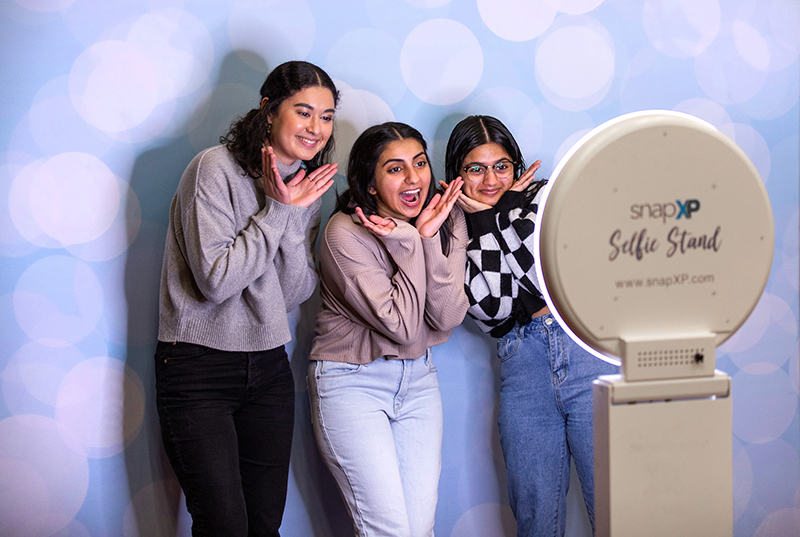
(l-r) Lulua Rawwas and Rabia and Noor Afzal posed for a photo during the WinterFest 2021. The photo station is one of dozens of free events in and around the Memorial Union for the campus community during this year's celebration, Friday, Dec. 2. Photo by Christopher Gannon.
An eve-of-prep week tradition to provide students with some Cyclone fun as fall semester winds down and exam week approaches, WinterFest 2022 will be held Friday, Dec. 2, in multiple campus locations. It's coordinated by the WinterFest student organization and student engagement office and supported by other offices at the Memorial Union (MU) and across campus. And while the focus is on students, nearly all WinterFest events are free to everyone -- students, staff, faculty and community members.
The MU will be headquarters for many of WinterFest's indoor events during the 4-9 p.m. window. From bowling to a caricature artist, swing dance lessons to photos with Santa, bingo to chair massages and plenty of free food -- chili, cornbread, cookies for decorating, hot chocolate and other seasonal beverages -- you'll find some fun at the MU.
President's open house
President Wendy Wintersteen and her spouse, Robert Waggoner, will host an open house on the ground floor of Beardshear Hall (4-6 p.m.). The university community is invited to enjoy live music by a student string quartet and complimentary hot chocolate, apple cider, cookies and ISU Creamery ice cream.
Campanile tours
ISU carillonneur and professor of music Tin-shi Tam, assisted by members of the Student Carillonneur Leadership Council, will lead tours of the campanile (4-6 p.m.). For safety reasons, each tour group is limited to nine people, and all participants must be at least 13 years old. Face masks are not required, but welcomed.
Helping our students
WinterFest organizers are collecting food items for SHOP, the food pantry in Beyer Hall serving students. Collection boxes will be in the MU West Lounge throughout WinterFest. Wondering what to donate? SHOP organizers maintain a list of especially needed nonperishable items.
Victorian yuletide
The Farm House Museum's current exhibition, Yuletide, includes special hours on Dec. 2 (5-8 p.m.) and Dec. 3 (1-4 p.m.). Enjoy Victorian-era activities and treats in the first building erected on campus (1860) as living quarters for the families of numerous Iowa State deans and professors.
Crafts HQ
The Workspace and ISU's Gaffer's Guild are cosponsoring their annual holiday sale of locally crafted items by artists with an Iowa State connection. Dec. 2 (noon-8 p.m., MU Art Gallery) is Day 3 of a four-day event. Items include blown glass (vases, vessels, ornaments, paperweights and sculptures), pottery, jewelry, upcycled bags and accessories, crocheted bags and hats, Art 2 Go kits and art mystery boxes.
Jingle Jog
First-Year Council's 16th annual Jingle Jog, a 4-kilometer run/walk around central campus, begins at 5:30 p.m.; check-in at 4 p.m., both on the lawn southeast of the campanile. Registration is $15 for all participants and can be completed online or on-site preceding the jog. Proceeds support a scholarship for a worthy council member in memory of former member Andy Albright, who died in a 2005 car accident.
Here are some WinterFest activities to consider; a full schedule is online.
- 9 a.m.-3 p.m., Poinsettia sale, horticulture club, Horticulture Hall atrium, $10-$40
- Noon-8 p.m., Art Mart holiday sale, local artists and crafters, MU Gallery
- 3-6 p.m., Christmas tree and wreath sale, forestry club, Reiman Gardens parking lot, $25-$100
- 4-5:15 p.m., check-in for Jingle Jog, near the campanile, run begins at 5:30 p.m., registration $15, includes T-shirt and swag
- 4-6 p.m., President's open house, ground floor, Beardshear Hall
- 4-6 p.m., Campanile tours, must be at least 13 years old, central campus
- 4-7 p.m., Caricatures, air brush tattoos, holiday crafts, various MU locations
- 4-9:30 p.m., Nonperishable food donation station, to benefit SHOP, MU west lounge
- 4-9:30 p.m. Chair massages, photo booth, card making for charities, bowling and billiards, various MU locations
- 5 p.m., Cookie decorating and hot chocolate, while supplies last, MU food court
- 5-7 p.m., Seasonal beverage sampling, MU Market and Café
- 5-8 p.m., Yuletide Evening, Farm House Museum, central campus
- 5-8 p.m., Swing dance lessons, photos with Santa, trivia games, various MU locations
- 5-9 p.m., Bingo, MU Sun Room
- 6 p.m., Tree-lighting ceremony, central campus near Beardshear Hall
- 6 p.m., Chili and cornbread, while supplies last, MU Pine Room
- 6-9:30 p.m., Horse-drawn carriages rides, leaving from the west drive, Memorial Union
- 7 p.m., Performance, Noah Sonie, magician and mentalist, MU Great Hall
- 9 p.m.-midnight, Ice skating, Ames/ISU Ice Arena, 1507 Gateway Hills Park Dr., first 800 participants receive free admission and skate rental
Editor's note: Earlier this week, author and actress Jennette McCurdy canceled her in-person appearances for the rest of 2022, including a moderated discussion scheduled for Friday evening in the MU Great Hall as part of WinterFest.
